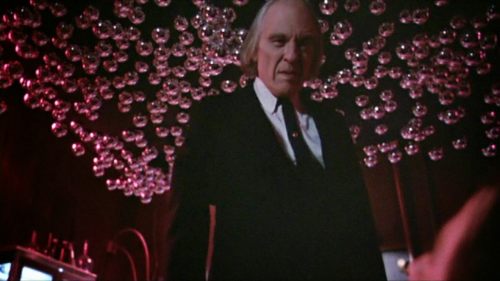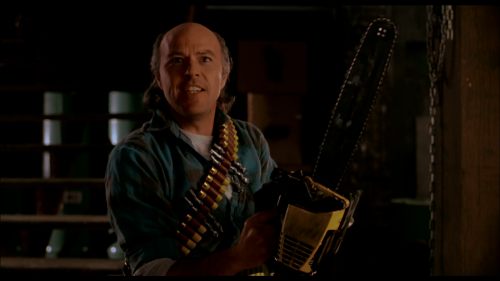Don Coscarelli Talks PHANTASM And Its Latest 4K Restoration
Phantasm is an all-timer. Don Coscarelli’s waking nightmare about a young boy, his big brother, an ice cream man, and the forces of evil they battle in Small Town, USA hasn’t lost an ounce of its ethereal intensity since it was first released in 1979. Now, Well Go Entertainment is distributing a brand new, utterly gorgeous 4K restoration of the film. To celebrate its arrival, Fantastic Fest is not only hosting a special screening of the film on September 24th but, in conjunction with the first annual Art House Theater Day, will live-stream it to select movie houses across the country (check out a list of participating theaters here).
We had the pleasure of talking with Coscarelli about his lo-fi horror masterwork and got a candid look at how technology can help a director recognize the limitations of their production, and even put an eraser to some of the flaws that’ve been bothering them for decades…
BMD: Phantasm is one of the most unique horror pictures ever made. What do you think accounts for its staying power nearly forty years on?
Don Coscarelli: When we made that movie all we were trying to do was make a little horror movie. The fact that it has any longevity whatsoever is still really stunning to me. Being the creator and at the center of the film’s universe, I think that question’s kind of hard to answer. But I will tell you the main theme is eternal. It’s about the fear of death and what happens after you die. Human beings are not going to answer those questions in our lifetime. Those are perpetual questions that will always stay relevant.
However, there are other elements of Phantasm that I’ve started to realize have accounted for the impact the movie had and still has on male teens. I always thought we were making a movie aimed toward the horror crowd with rather traditional iconography – an undertaker, graveyards, hearses, funerals. But in the process we ended up making this film that speaks specifically to male teens. We have this protagonist who’s an orphan and has an older brother whose attention he always craves. He’s driving around in his older brother’s car, shooting shotguns and drinking Mexican beer. It has a powerful effect when you’re a young male horror fan. I’ve had so many guys in their 30s, 40s and 50s come up to me and say “this movie had such a profound impact on me”, and I never saw that coming.
To be honest, a lot of it has to do with Angus Scrimm’s performance as the Tall Man. I wish I could take credit for it, but he created a monster that just resonates with people.
BMD: He became an icon.
You bring up the Mexican beer and shotguns – having the restoration play now for the third time in Texas (counting Fantastic Fest, SXSW and BNAT) seems super fitting.
DC: [laughs] I never thought about that! You’re right.
BMD: I’ve seen the movie on just about every format it’s been made available on – 35mm, VHS, DVD, and now this 4K DCP. Watching it jump resolutions between exhibition methods, you can pick out some of the production’s limitations – budgetary and otherwise. Was that something you were worried about when you were re-mastering the film? Or did you use this opportunity to tinker a bit?
DC: Oh, hell yeah. There are the obvious things we were able to improve – we removed every piece of tape and fishing line utilized in the creation of the silver spheres and how we made them fly. I always thought they were very obvious during the 35mm run. Yet on the Standard Def VHS and DVD, you could never see them.
The movie was made in a very guerrilla fashion, so there were flaws I didn’t even catch on the first go ‘round. Take for example the moment where the brothers enter that white room in the mausoleum, and there’s this weird yellow bucket in there. I don’t know where that yellow bucket came from! Everyone who watches this movie is so focused on the plot, story and atmosphere, and I’m sitting here going “what’s that bucket doing there? How did it get in the shot?” It’s torture for me to watch the movie sometimes, but we removed things like that which drove me crazy.
We also improved a few VFX shots that always bothered me, but were also careful not to overdo it. We didn’t want to lose the film’s charm. Also, we didn’t want to remove too much grain, except in the scenes where we were working with damaged negative. It still had to have that analog 35mm flavor. But there was this one visual effect that – at first I didn’t tell anybody, because I wanted to see if anyone would catch it at SXSW – nobody caught. It’s a profile close-up shot of the ball flying down the hallway and we had done it the old fashioned way: put it up against some black velvet to create the shot. But there was no movement in the shot and nothing reflecting off of the ball as it moved. So we tinkered with flaws like that. There’s the old adage that whenever filmmakers watch their own films all they see are the flaws and that’s totally the case with me.
This was the joy and good fortune of having JJ [Abrams] and his team working on the project. He had a top VFX guy named Andrew Kramer whip up a 20-frame shot of a completely synthetic sphere that looks spot on. You can even see the mausoleum flying by in the reflection.
BMD: The soundtrack is amazing, too. Did you beef that up at all?
DC: Oh yeah, you can really hear the power and wonder of the music now. Many of the sound effects also have much more impact – guns and cars and things like that. Even back in the day in 1979, we spent a lot of time getting that Mono soundtrack as perfect sounding as we could. But when the film was projected, they used to put it on Optical in Mono, and the Optical Soundtrack could only handle certain cycles. So anything over 9000 Hz would just cut off and anything below 500 Hz would just cut off. You’d lose a lot of the low and high end frequencies in the soundtrack. Now we have the whole spectrum.
BMD: You’re pointing out something that’s crucial regarding these restorations: sometimes there’s too much tinkering going on with refurbished Stereo soundtracks. The old Mono ones sound better on Blu-ray with less digital manipulation and just bits of emphasis instead.
DC: Exactly. You’re hearing it as we originally intended.
BMD: Tell me about the poster and how it came to be. The art’s quite striking while still feeling completely in touch with the one sheet that was originally used to promote the picture.*

DC: The artist’s name is Aaron Lea, and he’s a Texas guy too, actually. I met him when I was making Bubba Ho-Tep and he was just a die-hard Bruce Campbell/Evil Dead fanboy. He just wanted to get involved with something Bruce was involved with and blindly submitted a poster for Bubba Ho-Tep and it was just wonderful. So I got to know him and started working with him and he created the one sheet for Bubba Ho-Tep. And through the years he just started doing some work for me because he does web design and things like that. He’s a genre guy and has got his geek cred, so I went to him and asked what he thought we should do for Phantasm. His take was incredibly simple in that he thought we should incorporate all of the iconography from the original poster and reimagine it. It’s the key elements with Angus in the center, Mike falling, the lady in lavender, the spheres and then the hooded dwarf creatures. He took the original art that was done by Joe Smith and made a modern interpretation out of it. He did a great job and fans are going to appreciate it. We see reboots of movies all the time but we don’t see reboots of posters too often.
BMD: So now we have a 4K restoration of Phantasm and a beautiful Blu of my personal favorite, Part II, from Scream Factory. Are there any plans for Part(s) III and IV getting upgraded in the near future?
DC: I am confident that it is going to happen. There’s some work going on right now behind the scenes that is going to have Phantasm fans excited. I don’t know if that’s been announced yet, but I see the flaws in each one and I’m working to get them all up to snuff and ready to be enjoyed together.
But it’s thanks to the fans, Well Go Entertainment, Drafthouse, and Art House Theater Day because not only are we going to be booked into Fantastic Fest, they’ve essentially found a way to live-stream Phantasm into almost one hundred theaters across the country. It’s kind of an incredible experience, because here’s this weird movie from 1979 that’s going to be beamed into these houses across the United States where passionate film fans flock. It’s amazing.
BMD: One last question – can you tell me if you’re ever going to bring Survival Quest to Blu-ray? I love that movie so goddamn much.
DC: [laughs again] No current plans for Survival Quest. That’s one I’ve tinkered with before with some sound work and judicious editing when Anchor Bay put it out in Standard Def in the mid-2000s. No Blu-ray yet, though.
There is one that stars a bunch of the Phantasm actors – Kenny & Co. – that I really want to work on as Anchor Bay did a really nice DVD of that, but then they lost the licensing. So I’d really love to do an HD version of that for someone, too.
BMD: Well, I hope it happens, because I don’t think you’ve made a movie I flat out dislike yet.
DC: Hey man, thanks. That means a lot.
---
Some additional notes:
Posters will be given away and/or raffled off in many of the theaters on Art House Theater Day and also are available for purchase on phantasm.com.
The Art House Day screenings will include not only Phantasm: Remastered, but also the first behind-the-scenes look at the making of Phantasm: Ravager with tribute to star Angus Scrimm and live streamed Q&A from Fantastic Fest.
All five Phantasm films will be available for the first time in HD on October 4, with Phantasm: Remastered and Phantasm: Ravager being released in theaters on October 7.



